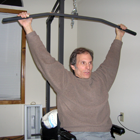
Bob Mikesic recognizes the importance of physical activity. His home has an area that houses fitness equipment, including stretch cables, dumbbells, and a lat pull machine that facilitates stretching and strengthening. He wheels for aerobic exercise, and occasionally swims.
Bob was 17 when he had a spinal cord injury and had been very involved in school sports before that. He recalls several reasons for his interest in working out at that age: his friends were into it, it felt good to be in shape, and he wanted to boost his performance in sports. After his SCI, Bob found that staying fit made transfers and walking with crutches, which he did for a few years after the injury, easier.
Now in his fifties, Bob maintains his strength and flexibility to reduce aches and pains, particularly in his shoulders. Exercising regularly makes it easier to wheel to maintain a healthy weight. Typically, he performs a complete strengthening routine three times weekly and uses small weights while watching TV. He lost his dog and walking companion, Century, to old age last year. But Bob lives in a neighborhood with good sidewalks that is close to a nature preserve with flat, paved trails that make wheeling fun. Bob recommends that other wheelchair users trying to increase physical activity and fitness levels should listen to their bodies. Not overextending muscles and figuring out ways to continue using them without aggravating injuries are important. He advises others to try different types of exercise to find out what works best. Finding activities he can do at home and in his neighborhood are important to him. He says, “Once I get home after work I'm not interested in going out to a gym to exercise."
Bob also recommends Push EaseTM gloves, particularly half finger, full thumb gloves in the summer, to protect hands while wheeling. The increased grip they provide is an actual source of encouragement that helps him stick with his healthy routine.
